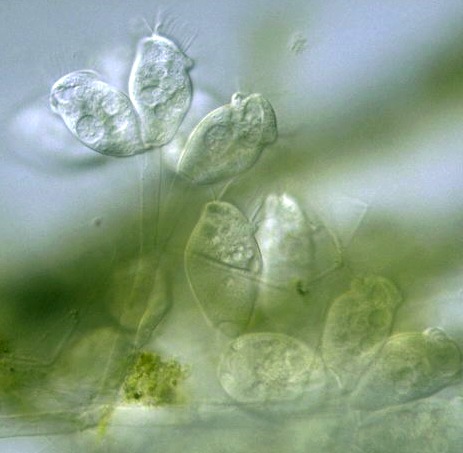 Genus: Colonial; without lorica; less than 3 turns of oral cilia; swarmer with median scopula
(Illustrated Guide, 1985).
Stalk not contractile; body contractile.
Genus: Colonial; without lorica; less than 3 turns of oral cilia; swarmer with median scopula
(Illustrated Guide, 1985).
Stalk not contractile; body contractile.
Species:
 Genus: Colonial; without lorica; less than 3 turns of oral cilia; swarmer with median scopula
(Illustrated Guide, 1985).
Stalk not contractile; body contractile.
Genus: Colonial; without lorica; less than 3 turns of oral cilia; swarmer with median scopula
(Illustrated Guide, 1985).
Stalk not contractile; body contractile.
Species: |





* Epistylis microdiscum Stiller, 1963: Cell body ovoid, 45-55 μm long, 30-35 μm wide; pellicle slightly striated; peristomal disc like mound; cytopharynx straight 1/4 of cell length; contractile vacuole near peristome; macronucleus C-shaped (Zensei-Doubutu Zukan, 1981).
Epistylis lacustris Imhoff, 1884: Cell body cylindroid; 50-75 μm long, 20-35 μm wide; pellicle striated; peristomal disc mounded; cytopharynx 1/2 of cell body; macronucleus C-shaped; stalk branches dichotomously with longitudinal fine striation (Zensei-Doubutu Zukan, 1981).
Epistylis chrysemidis:
230-250 μm long; extra collar around
peristome when expanded; cytopharynx large, deep; stalk branches dichotomously lacking
myonemes; fresh water (How to know the protozoa, 1979).
Epistylis cambari:
Peristome 50 μm; common on gills of
crayfish (How to know the protozoa, 1979).
Epistylis niagarae:
Up to 180 μm long; on western painted turtle
(How to know the protozoa, 1979).
Epistylis urceolata:
160 μm long; common on larvae of
Chironomus (How to know the protozoa, 1979).